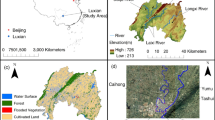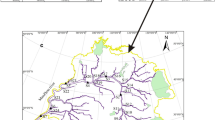Abstract
The study on environmental risk of surface water is of great practical significance for the ecological security of water environment and water pollution treatment, and it can provide a certain reference basis for risk prevention and control of water environment. The Tianjin Binhai New Area faces severe water shortage and serious water pollution, but few studies have been reported on surface water environment risk in this area. Therefore, in this study, based on Gaofen-6 remote sensing image, the factors including land use, landscape index, population density, and enterprise source are integrated to develop the evaluation model of surface water environment risk index. It is developed using analytic hierarchy process from two aspects of hazard of risk source and sensitivity of risk receptor. The comprehensive risk of Tianjin Binhai New Area is classified using mean standard deviation method. The result indicates that the developed model could better quantify the impact of various factors on the surface water environment, and comprehensively and accurately depict the spatial distribution of surface water environmental risk. Generally, the areas of higher and high risk grades are mainly concentrated on the west of Binhai Street, Beitang Street, and Hangzhou Road Street. The risk grade in most other areas is medium, and it is low in coastal and northernmost areas. This study not only clarifies the distribution of surface water environmental risks in Binhai New Area, but also develops an evaluation model, which can provide reference for the evaluation of water environmental risks in other areas. Through the investigation and research on the current situation of water pollution, social and economic development, and other factors of the streets and towns in Binhai New Area, it is found that in recent years, the urbanization of Binhai Street, Beitang Street, and Hangzhou Road Street has developed rapidly, and the intensity of human activities is high, which has a great impact on the water environment. The research results are consistent with the actual situation, which can provide theoretical and technical support for the prevention, control, and management of water environmental risks in Binhai New Area.







Similar content being viewed by others
Data availability
The data that support the findings of this study are available from the authors upon reasonable request.
Change history
04 October 2021
A Correction to this paper has been published: https://doi.org/10.1007/s10661-021-09473-5
References
Awoke, A., Beyene, A., Kloos, H., Goethals, P. L. M., & Triest, L. (2016). River water pollution status and water policy scenario in Ethiopia: Raising awareness for better implementation in developing countries. Environmental Management, 58(4), 1–13. https://doi.org/10.1007/s00267-016-0734-y
Barałkiewicz, D., Chudzińska, M., Szpakowska, B., Świerk, D., Gołdyn, R., & Dondajewska, R. (2014). Storm water contamination and its effect on the quality of urban surface waters. Environmental Monitoring and Assessment, 186, 6789–6803. https://doi.org/10.1007/s10661-014-3889-0
Bujnovský, R., Malík, P., & Švasta, J. (2016). Evaluation of the risk of diffuse pollution of groundwater by nitrogen substances from agricultural land use as background for allocation of effective measures. Ekológia, 35(1), 66–77. https://doi.org/10.1515/eko-2016-0005
Chen, Q., Liu, J., Ho, K. C., & Yang, Z. (2012). Development of a relative risk model for evaluating ecological risk of water environment in the Haihe River Basin estuary area. Science of the Total Environment, 420, 79–89. https://doi.org/10.1016/j.scitotenv.2011.09.044
Chen, Q., Lu, Z., Zhang, X., Wang, Q., & Xin, S. (2019). Study on the accumulation characteristics and conduction trend of water environment risk from Taizihe River Basin China. Ecotoxicology, 28(6), 619–630. https://doi.org/10.1007/s10646-019-02058-6
Davids, J. C., Rutten, M. M., Shah, R. D. T., Shah, D. N., Devkota, N., Izeboud, P., Pandey, A., & van de Giesen, N. (2018). Quantifying the connections—linkages between land-use and water in the Kathmandu Valley Nepal. Environmental Monitoring and Assessment, 190, 304. https://doi.org/10.1007/s10661-018-6687-2
Di, H., Liu, X., Zhang, J., Tong, Z., & Ji, M. (2018). The spatial distributions and variations of water environmental risk in Yinma River Basin China. International Journal of Environmental Research and Public Health, 15(3), 521. https://doi.org/10.3390/ijerph15030521
Feng, L., Cheng, Y., Zhang, Y., Li, Z., Yu, Y., Feng, L., Zhang, S., & Xu, L. (2020). Distribution and human health risk assessment of antibiotic residues in large-scale drinking water sources in Chongqing area of the Yangtze River. Environmental Research, 185, 109386. https://doi.org/10.1016/j.envres.2020.109386
Guo, S., Bai, H., Meng, Q., Huang, X., & Zeng, Q. (2018). Landscape pattern change and its response to anthropogenic disturbance in the Qinling Mountains during 1980 to 2015. The Journal of Applied Ecology, 29(12), 4080–4088. https://doi.org/10.13287/j.1001-9332.201812.018
Huan, H., Ma, X., Lian, X., & Jia, Y. (2019). How to establish the emergency prevention and control system for sudden water pollution accidents Taking Tianjin Binhai Industrial belt as an example. Environmental Economy, 16, 38–43.
Irene, N., Adrián, D. L. T., Paloma, S., & María, D. L. A. M. (2020). Perfluoroalkyl acids (PFAAs): Distribution, trends and aquatic ecological risk assessment in surface water from Tagus River basin (Spain). Environmental Pollution, 256, 113511. https://doi.org/10.1016/j.envpol.2019.113511
Islam, K. I. (2015). A model of indexes and GIS maps for the assessment of water resource. Journal of Water Resource and Protection, 7(13), 973–987. https://doi.org/10.4236/jwarp.2015.713079
Jin, C., Wang, Y., & Gong, L. (2018). Risk assessment of sudden water pollution in Lanzhou section of Yellow River based on fuzzy hierarchy evaluation method. Journal of Safety and Environment, 18(1), 363–368. https://doi.org/10.13637/j.issn.1009-6094.2018.01.068
Kura, N. U., Ramli, M. F., Ibrahim, S., Sulaiman, W. N. A., Aris, A. Z., Tanko, A. I., & Zaudi, M. A. (2015). Assessment of groundwater vulnerability to anthropogenic pollution and seawater intrusion in a small tropical island using index-based methods. Environmental Science and Pollution Research, 22(2), 1512–1533. https://doi.org/10.1007/s11356-014-3444-0
Liang, J., & Li, X. (2018). Characteristics of temporal-spatial differentiation in landscape pattern vulnerability in Nansihu Lake wetland China. The Journal of Applied Ecology, 29(2), 626. https://doi.org/10.13287/j.1001-9332.201802.018
Li, M., Guo, X., Yang, M., Tao, R. X., Shen, S., & Xiong, H. (2020). Analysis of influent water quality characteristics of wastewater treatment plant in Tianjin Binhai New Area. Industrial Water and Wastewater, 51(4), 16–20.
Liu, X., Tan, C., Wang, J., Gao, Y., & Fu, Q. (2015). Study on ecological water system planning of Tianjin Binhai New Area. China Urban Science Research Association, 1–5.
Li, W., Hua, T., Zhou, Q., Zhang, S., & Rong, W. (2011). Toxicity identification and high-efficiency treatment of aging chemical industrial wastewater from the Hangu Reservoir China. Journal of Environmental Quality, 40(6), 1714–1721. https://doi.org/10.2134/jeq2010.0319
Li, Y., Li, W., Wang, B., Liu, X. W., Xie, Y. L., & Liu, L. (2015). An inexact multi-objective programming model for water resources management in industrial parks of Binhai New Area, China. Water Science and Technology: A Journal of the International Association on Water Pollution Research, 72(10), 1879–1888. https://doi.org/10.2166/wst.2015.413
McGarigal, K., Cushman, S. A., & Ene, E. (2012). FRAGSTATS v4: Spatial pattern analysis program for categorical and continuous maps. University of Massachusetts Amherst. http://www.umass.edu/landeco/research/fragstats/fragstats.html
Sahana, M., & Ganaie, T. A. (2017). GIS-based landscape vulnerability assessment to forest fire susceptibility of Rudraprayag district Uttarakhand India. Environmental Earth Sciences, 76(20), 676. https://doi.org/10.1007/s12665-017-7008-8
Shen, Z., Chen, L., & Chen, T. (2013). The influence of parameter distribution uncertainty on hydrological and sediment modeling: A case study of SWAT model applied to the Daning watershed of the Three Gorges Reservoir Region China. Stochastic Environmental Research and Risk Assessment, 27(1), 235–251. https://doi.org/10.1007/s00477-012-0579-8
Tian, P., Wu, H., Yang, T., Zhang, W., Jiang, F., Zhang, Z., & Wu, T. (2019). Environmental risk assessment of accidental pollution incidents in drinking water source areas: A case study of the Hongfeng Lake Watershed China. Sustainability, 11(19), 5403. https://doi.org/10.3390/su11195403
Vitousek, P. M., Mooney, H. A., Lubchenco, J., & Melillo, J. M. (1997). Human domination of earth’s ecosystem. Science, 277(5325), 494–499. https://doi.org/10.1126/science.277.5325.494
Wang, M., Cheng, Y., Guo, B., & Jin, S. (2019). Parameters determination and sensor correction method based on virtual CMOS with distortion for the GaoFen6 WFV camera. ISPRS Journal of Photogrammetry and Remote Sensing, 156, 51–62. https://doi.org/10.1016/j.isprsjprs.2019.08.001
Wei, J., Zhang, N., Cheng, Q., Wu, S., & Liu, Z. (2020). Simulation and evaluation of the spatial heterogeneity of shallow-groundwater environmental risk in an urban–rural fringe of megacity: A case study of Shenyang city northeast China. Environmental Earth Sciences, 79(11), 250. https://doi.org/10.1007/s12665-020-08975-8
Xiao, Y., Huang, S., Zhou, J., Kong, F., Liu, M., & Li, Y. (2018). Risk assessment of Upper-Middle reaches of Luanhe River Basin in sudden water pollution incidents based on control units of water function areas. Water, 10(9), 1268–1287. https://doi.org/10.3390/w10091268
Xie, Y. L., Li, Y. P., Huang, G. H., Li, Y. F., & Chen, L. R. (2011). An inexact chance-constrained programming model for water quality management in Binhai New Area of Tianjin China. Science of the Total Environment, 409(10), 1757–1773. https://doi.org/10.1016/j.scitotenv.2011.01.036
Xiong, H., Guo, X., Shen, S., Tao, R., Sun, Y., Yang, M., & Li, M. (2020). Suggestions for improving the quality and efficiency of wastewater treatment in Tianjin Binhai New Area. Tianjin Science and technology, 47(5), 84–86 + 93. https://doi.org/10.14099/j.cnki.tjkj.2020.05.026
Yang, A., Zhong, B., Hu, L., Wu, S., Xu, Z., Wu, H., Wu, J., Gong, X., Wang, H., & Liu, Q. (2020). Radiometric cross-calibration of the wide field view camera onboard GaoFen-6 in multispectral bands. Remote Sensing, 12(6), 1037. https://doi.org/10.14099/j.cnki.tjkj.2020.05.026
Yao, H., Li, W., & Qian, X. (2015). Identification of major risk source for surface water pollution by risk indices (RI) in the multi-provincial boundary region of the Taihu Basin China. International Journal of Environmental Research and Public Health, 12(8), 10150–10170. https://doi.org/10.3390/ijerph120810150
Yousef, A. A., Mimi, H. H., Shaik, M. S., & Aishsh, A. J. (2018). Hybrid tool for occupational health risk assessment and fugitive emissions control in chemical processes based on the source, path and receptor concept. Process Safety and Environmental Protection, 348-360. https://doi.org/10.1016/j.psep.2018.06.032
Yuan, Y., Liu, Y., Luo, K., & Shahid, M. Z. (2020). Hydrochemical characteristics and a health risk assessment of the use of river water and groundwater as drinking source in a rural area in Jiangjin District China. Environmental Earth Sciences, 79(7), 160. https://doi.org/10.1007/s12665-020-8900-1
Zhang, C., Dong, L., Liu, Y., Qiao, H., & Rosen, M. A. (2016). Analysis on impact factors of water utilization structure in Tianjin China. Sustainability, 8(3), 241. https://doi.org/10.3390/su8030241
Zhang, W., & Liu, Y. (2018). Comprehensive risk assessment of the Luojiang River basin water environment in Western Guangdong Province. Desalination and Water Treatment, 125, 171–178. https://doi.org/10.5004/dwt.2018.22838
Zhang, Y., Guo, C., Xu, J., Tian, Y., Shi, G., & Feng, Y. (2012). Potential source contributions and risk assessment of PAHs in sediments from Taihu Lake China: Comparison of three receptor models. Water Research, 46(9), 3065–3073. https://doi.org/10.1016/j.watres.2012.03.006
Zhou, H., Huang, J., Gao, J., Yan, R., Peng, Y., Cao, J., & Shang, Z. (2019). Potential risk assessment of sudden water pollution around Taipu River in Taihu Basin. Lake Science, 31(3), 646–655.
Zhou, Q., Pang, Y., Wang, X., Wang, X., Niu, Y., Wang, J., & Torretta, V. (2017). Determination of key risk supervision areas around river-type water source affected by multiple risk source: A case study of water source along the Yangtze’s Nanjing Section. Sustainability, 9(2), 283. https://doi.org/10.3390/su9020283
Zhou, Y., Pu, L., & Zhu, M. (2020). Coastal landscape vulnerability analysis in Eastern China—based on land-use change in Jiangsu Province. International Journal of Environmental Research and Public Health, 17(5), 1702. https://doi.org/10.3390/ijerph17051702
Funding
This work was supported by the Natural Science Foundation of Tianjin, China (grant number No. 18JCYBJC90900), and the Scientific Research Project of Tianjin municipal Education Commission, China (grant number No. 2018KJ164).
Author information
Authors and Affiliations
Contributions
All of the authors contributed extensively to the work. Yue Qiao analyzed date and wrote the article. Qiaozhen Guo conceived the idea and gave suggestions on modification of the manuscript. Xiaoxu Wu modified the manuscript. Huanhuan Wu processed the data. Li Zhu and Yunhai He analyzed the data. All authors were involved in writing and revising the manuscript.
Corresponding authors
Ethics declarations
Conflict of interest
The authors declare no competing interests.
Additional information
Publisher's Note
Springer Nature remains neutral with regard to jurisdictional claims in published maps and institutional affiliations.
Rights and permissions
About this article
Cite this article
Qiao, Y., Guo, Q., Wu, X. et al. Environmental risk analysis of surface water based on multi-source data in Tianjin Binhai New Area, China. Environ Monit Assess 193, 481 (2021). https://doi.org/10.1007/s10661-021-09273-x
Received:
Accepted:
Published:
DOI: https://doi.org/10.1007/s10661-021-09273-x




